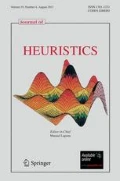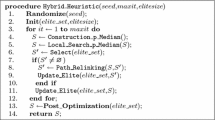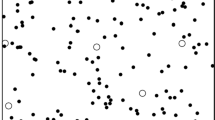Abstract
Given n customers and a set F of m potential facilities, the p-median problem consists in finding a subset of F with p facilities such that the cost of serving all customers is minimized. This is a well-known NP-complete problem with important applications in location science and classification (clustering). We present a multistart hybrid heuristic that combines elements of several traditional metaheuristics to find near-optimal solutions to this problem. Empirical results on instances from the literature attest the robustness of the algorithm, which performs at least as well as other methods, and often better in terms of both running time and solution quality. In all cases the solutions obtained by our method were within 0.1% of the best known upper bounds.
Similar content being viewed by others
References
Aiex, R.M., M.G.C. Resende, P.M. Pardalos, and G. Toraldo. (2004). “GRASP with Path Relinking for the Three-Index Assignment Problem.” INFORMS Journal on Computing.
Avella, P., A. Sassano, and I. Vasil'ev. (2003). “Computational Study of Large-Scalep-Median Problems”. Technical Report 08-03, DIS-Universitá di Roma “La Sapienza”.
Beasley, J.E. (1985). “A Note on Solving Large p-Median Problems”. European Journal of Operational Research 21, 270–273.
Cornuéjols, G., M.L. Fisher, and G.L. Nemhauser. (1977). “Location of Bank Accounts to Optimize Float: An Analytical Study of Exact and Approximate Algorithms.” Management Science 23, 789–810.
Dongarra, J.J. (2003). “Performance of Various Computers Using Standard Linear Equations Software.” Technical Report CS-89-85, Computer Science Department, University of Tennessee.
du Merle, O., D. Villeneuve, J. Desrosiers, and P. Hansen. (1999). “Stabilized Column Generation.” Discrete Mathematics 194, 229–237.
Feo, T.A. and M.G.C. Resende. (1989). “A Probabilistic Heuristic for a Computationally Difficult Set Covering Problem.” Operations Research Letters 8, 67–71.
Feo, T.A. and M.G.C. Resende. (1995). “Greedy Randomized Adaptive Search Procedures.” Journal of Global Optimization 6, 109–133.
Galvão, R.D. (1980). “A Dual-Bounded Algorithm for the p-Median Problem.” Operations Research 28, 1112–1121.
Galvão, R.D. and C.S. ReVelle. (1996). “A Lagrangean Heuristic for the Maximal Covering Problem.” European Journal of Operational Research 18, 114–123.
García-López, F., B. Melián-Batista, J.A. Moreno-Pérez, and J.M. Moreno-Vega. (2002). “The Parallel Variable Neighborhood Search for thep-Median Problem.” Journal of Heuristics 8(3), 375–388.
García-López, F., B. Melián-Batista, J.A. Moreno-Pérez, and J.M. Moreno-Vega. (2003). “Parallelization of the Scatter Search for the p-Median Problem.” Parallel Computing 29(5), 575–589.
Glover, F. (1996). “Tabu Search and Adaptive Memory Programming: Advances, Applications and Challenges.” In R.S. Barr, R.V. Helgason, and J.L. Kennington (eds.), Interfaces in Computer Science and Operations Research. Kluwer, pp. 1-75.
Glover, F., M. Laguna, and R. Martí. (2000). “Fundamentals of Scatter Search and Path Relinking.” Control and Cybernetics 39, 653–684.
Goldberg, D.E. (1989). Genetic Algorithmis in Search, Optimization and Machine Learning. Addison-Wesley.
Goodchild, M.F. and V. Noronha. (1983). “Location-Allocation for Small Computers.” Monograph 8, Department of Geography, University of Iowa.
Hansen, P. and N. Mladenovi?. (1997). “Variable Neighborhood Search for the p-Median.” Location Science 5, 207–226.
Hansen, P., N. Mladenovi?, and D. Perez-Brito. (2001). “Variable Neighborhood Decomposition Search.” Journal of Heuristics 7(3), 335–350.
Hodgson, M.J. (1978). “Toward More Realistic Allocation in Location-Allocation Models: An Interaction Approach.” Environment and Planning A 10, 1273–1285.
Kariv, O. and L. Hakimi. (1979). “An Algorithmic Approach to Nework Location Problems, Part II: The p-Medians.” SIAM Journal of Applied Mathematics 37(3), 539–560.
Kuehn, A.A. and M.J. Hamburger. (1963). “A Heuristic Program for Locating Warehouses.” Management Science 9(4), 643–666.
Laguna, M. and R. Martí. (1999). “GRASP and Path Relinking for 2-Layer Straight Line Crossing Minimization.” INFORMS Journal on Computing 11, 44–52.
Maranzana, F.E. (1964). “On the Location of Supply Points to Minimize Transportation Costs.” Operations Research Quarterly 15(3), 261–270.
Matsumoto, M. and T. Nishimura. (1998). “Mersenne Twister: A 623-Dimensionally Equidistributed Uniform Pseudorandom Number Generator.” ACM Transactions on Modeling and Computer Simulation 8(1), 3–30.
Michalewicz, Z. (1994). Genetic Algorithms + Data Structures = Evolution Programs. Springer-Verlag, second edition.
Mladenovi?, N. and P. Hansen. (1997). “Variable Neighbourhood Search.” Computers and Operations Research 24, 1097–1100.
Nauss, R.M. and R.E. Markland. (1981). “Theory and Application of an Optimizing Procedure for Lock Box Location Analysis.” Management Science 27, 855–865.
Rao, M.R. (1971). “Cluster Analysis and Mathematical Programming.” Journal of the American Statistical Association 66(335), 622–626.
Reinelt, G. (1991). “TSPLIB: A Traveling Salesman Problem Library.” ORSA Journal on Computing 3, 376–384. http://www.iwr.uni-heidelberg.de/groups/comopt/software/TSPLIB95/.
Resende, M.G.C. and C.C. Ribeiro. (2003). “Greedy Randomized Adaptive Search Procedures.” In F. Glover and G. Kochenberger (eds.), Handbook of Metaheuristics. Kluwer, pp. 219-249.
Resende, M.G.C. and R.F.Werneck. (2002). “A GRASP with Path-Relinking for the p-Median Problem.”Technical Report TD-5E53XL, AT&T Labs Research.
Resende, M.G.C. and R.F. Werneck. (2003). “On the Implementation of a Swap-Based Local Search Procedure for thep-Median Problem.” In R.E. Ladner (ed.), Proceedings of the Fifth Workshop on Algorithm Engineering and Experiments (ALENEX'03), SIAM, pp. 119-127.
Ribeiro, C.C., E. Uchoa, and R.F. Werneck. (2002). “A Hybrid GRASP with Perturbations for the Steiner Problem in Graphs.” INFORMS Journal on Computing 14(3), 228–246.
Rolland, E., D.A. Schilling, and J.R. Current. (1996). “An Efficient Tabu Search Procedure for the p-Median Problem.” European Journal of Operational Research 96, 329–342.
Rosing, K.E. (1997). “An Empirical Investigation of the Effectiveness of a Vertex Substitution Heuristic.” Environment and Planning B 24, 59–67.
Rosing, K.E. and C.S. ReVelle. (1997). “Heuristic Concentration: Two stage Solution Construction.” European Journal of Operational Research 97, 75–86.
Rosing, K.E., C.S. ReVelle, E. Rolland, D.A. Schilling, and J.R. Current. (1998). “Heuristic Concentration and Tabu Search: A Head to Head Comparison.” European Journal of Operational Research 104, 93–99.
Rosing, K.E., C.S. ReVelle, and H. Rosing-Vogelaar. (1979). “The p-Median and its Linear Programming Relaxation: An Approach to Large Problems.” Journal of the Operational Research Society 30(9), 815–823.
Senne, E.L.F. (2002). Personal communication.
Senne, E.L.F. and L.A.N. Lorena. (2000). “Langrangean/Surrogate Heuristics for p-Median Problems.” In M. Laguna and J.L. González-Velarde (eds.), Computing Tools for Modeling, Optimization and Simulation: Interfaces in Computer Science and Operations Research. Kluwer, pp. 115-130.
Senne, E.L.F. and L.A.N. Lorena. (2004). “Stabilizing Column Generation using Lagrangean/Surrogate Relaxation: An Application to p-Median Location Problems.” European Journal of Operational Research, to appear.
Taillard, E.D. (2003). “Heuristic Methods for Large Centroid Clustering Problems.” Journal of Heuristics 9(1), 51–74.
Tansel, B.C., R.L. Francis, and T.J. Lowe. (1983). “Location on Networks: A Survey.” Management Science 29(4), 482–511.
Teitz, M.B. and P. Bart. (1968). “Heuristic Methods for Estimating the Generalized Vertex Median of a Weighted Graph.” Operations Research 16(5), 955–961.
Thorup, M. (2001). “Quick k-Median, k-Center, and Facility Location for Sparse Graphs.” In Proceedings of the 28th International Colloquium on Automata, Languages and Programming (ICALP 2001), Vol. 2076 ofLecture Notes in Computer Science. pp. 249-260, Springer.
Vinod, H.D. (1969). “Integer Programming and the Theory of Groups.” Journal of the American Statistical Association 64(326), 506–519.
Voß, S. (1996). “A Reverse Elimination Approach for the p-Median Problem.” Studies in Locational Analysis 8, 49–58.
Whitaker,R. (1983). “A Fast Algorithm for the Greedy Interchange of Large-Scale Clustering and Median Location Prolems.” INFOR 21, 95–108.
Author information
Authors and Affiliations
Rights and permissions
About this article
Cite this article
Resende, M.G., Werneck, R.F. A Hybrid Heuristic for the p-Median Problem. Journal of Heuristics 10, 59–88 (2004). https://doi.org/10.1023/B:HEUR.0000019986.96257.50
Issue Date:
DOI: https://doi.org/10.1023/B:HEUR.0000019986.96257.50




